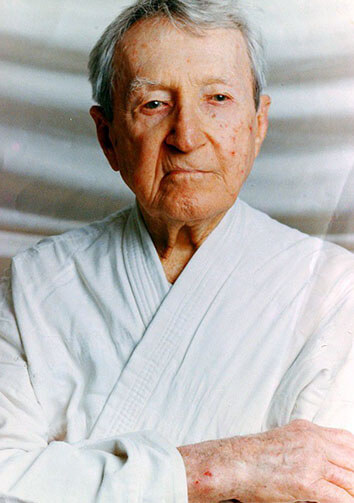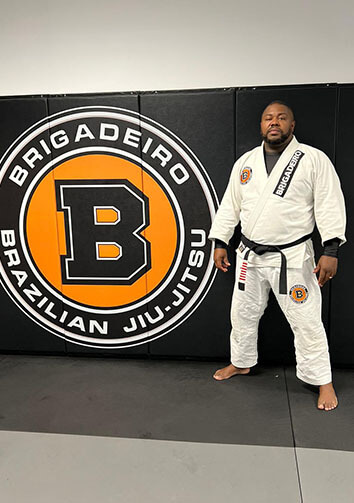Best self-defense system in the world, come check it out, join us.
About Brazilian Jiu-Jitsu
Best self-defense system in the world, come check it out, join us.

History of Brazilian Jiu-Jitsu

The origins of Jiu-Jitsu, “gentle art” in Japanese, came from India where it was developed by Buddhist monks.
Concerned with self-defense, the monks developed a technical system based on the principles of balance, body articulation, and leverage, avoiding the use of force and weapons.
With the spread of Buddhism, Jiu-Jitsu traveled through Southeast Asia, and China where it finally reached Japan, where it developed and became popular.
From the 19th century onwards, some Jiu-Jitsu Masters migrated from Japan to other continents, living off the teaching of martial arts and the fights they organized.
Mitsuyo Esai Maeda, known as Count Koma, was there. After traveling with his troupe fighting in several countries in Europe and America, he arrived in Brazil in 1915 and settled in Belém in the State of Pará. 1916, where he met Gastão Gracie, Father of eight children, five men and three women, Gastão became a Jiu-Jitsu enthusiast and took his eldest son Carlos Gracie to learn to fight with the Japanese.
Slim by nature, at 15 years old Carlos Gracie found in Jiu-Jitsu a personal fulfillment. At age 19, he moved to Rio de Janeiro with his family and became a professional Jiu-Jitsu fighter. Fighting Jiu-Jitsu and Professor, he traveled to Belo Horizonte and then to São Paulo giving classes and defeating opponents who were physically much stronger than him.
In 1925, he returned to Rio and opened the first Gracie Jiu-Jitsu Academy. He invited his brothers Oswaldo and Gastão to help him and take over the education of young George Gracie 14 years old and Hélio Gracie 12 years old. From then on, Carlos Gracie passed on his knowledge to his brothers, adapting and perfecting the technique for the physique characteristic of his family. He also conveyed his philosophy of life and concepts of natural food. He pioneered the creation of a special diet for athletes, the Gracie Diet, making Jiu-Jitsu synonymous with health.
With an efficient Self Defense Technique, Carlos Gracie saw in Jiu-Jitsu a way to become a more tolerant, respectful, and self-confident man. Seeing the superiority of the Jiu-Jitsu that he developed, he began the development in the core of the Family, becoming a family tradition. Carlos Gracie challenged the great fighters of his time, winning them all! Then he went on to manage his brothers’ careers. Facing opponents 20 or 30 kilos heavier, the Gracie family soon acquired national and international fame and notoriety.
Attracted by the new market that opened around Ju-Jitsu, many Japanese came to Rio de Janeiro, but none of them formed a school as solid as Academia Gracie.
The Jiu-Jitsu that they trained favored the training of takedowns (what we know as Judo) and the Gracie’s improved the ground fighting and finishing moves.
By modifying the international rules of Japanese Jiu-Jitsu that he and his brothers trained and taught, Carlos Gracie started the First case of change of Nationality of a fight or sport, in the history of the world sport.
Years later, the Japanese martial art was renamed Brazilian Jiu-Jitsu, being recognized WORLDWIDE AS A FIGHT OF BRAZILIAN ORIGIN, and being exported all over the world, including Japan.
History of Eduardo Brigadeiro

Eduardo “Brigadeiro” is a disciple of God, Married, Father of 4 CHILDREN, has degrees in Physical Education (2000) and Lato Sensu MBA in Sports Management and Marketing (2002), both by Gama Filho University.
6th Degree Black Belt in Brazilian Jiu-Jitsu, Judo Black Belt and Kru Muay Thai.
His history with Martial Arts began when his parents enrolled him in Judo at the age of 5. Eduardo Brigadeiro was born and raised in Rio de Janeiro in the Barra da Tijuca neighborhood and on the mats, he won several championships in his Judo category at a youthful age, becoming one of the main athletes of his generation. He started Jiu-Jitsu in 1984 and never stopped practicing the gentle art, in 1997 he was graduated to black belt by his Master Ricardo De La Riva.
Recognized and certified by the CBJJ – Brazilian Jiu-Jitsu Confederation and by the sport’s largest body, the IBJJF – International Brazilian Jiu-Jitsu Federation, Eduardo Brigadeiro participated in the main National and International Jiu-Jitsu competitions. He won State and National and International titles, highlighting the achievement of Bronze in the First Jiu-Jitsu World Cup in 1996, among others.
He has a vast collection of medals and trophies under his belt as an athlete. Professor Eduardo Brigadeiro has a very expressive curriculum. He is a true trainer of champions. Eduardo Brigadeiro has a historic title on his resume. He was Professor and Coach of the first Female Athlete World Champion of Jiu-Jitsu in the women’s division, the Brazilian Thais Ramos, a title won in the 1999 Worlds. In 2014, Eduardo Brigadeiro, motivated by a new challenge, moved to the United States to study and expand BRIGADEIRO JIU-JITSU on North American soil. The city chosen was Jacksonville in Florida where he lives to this day.
Academy history

It all started in the early 90’s with the end of Academia Clube Barra, famous for training great athletes and for being the creator of the Main and Traditional BRAZILIAN JIU-JITSU event held annually in Rio de Janeiro. The South Atlantic Cup as it was called brought together the best and Brazil’s top fighters. With the departure of the main teachers of Clube Barra to the United States, their activities and responsibility were left with the student and Professor Eduardo Venâncio “Brigadeiro” (only 17 years old at the era).
In 1992 with the growth of JIU-JITSU SPORT, Eduardo Brigadeiro joined the students who stayed with him and decided to develop and create the BRIGADEIRO JIU-JITSU, academy that has its origins in BARRA DA TIJUCA, the noblest area of the city of RIO DE JANEIRO.
In 1995 EDUARDO BRIGADEIRO started the expansion of BRIGADEIRO JIU-JITSU by opening its first branch in Barra da Tijuca, Rio de Janeiro, in the same neighborhood where the headquarters are located today.
In 1997 the horizons widened and the expansion of the first branches outside of Rio de Janeiro began, in BRASILIA, Capital of BRASIL and soon after that in the same year the branches in the cities of CASCAVEL and MARINGÁ were opened in the state of PARANÁ.
In the mid-2000s Eduardo Brigadeiro traveled to Europe for the first time and established the FIRST INTERNATIONAL BRANCH of Brigadeiro Jiu-Jitsu in Portugal, BEING THE PIONEER IN BRAZILIAN JIU-JITSU IN PORTUGAL. The expansion did not stop there, Eduardo Brigadeiro continued the challenge of taking BRIGADEIRO JIU-JITSU IN THE EUROPEAN CONTINENT AND IN OTHER COUNTRIES.
CURRENTLY, BRIGADEIRO JIU-JITSU CAN BE FOUND IN SOME COUNTRIES AROUND THE WORLD.
Over its 30 years of foundation, BRIGADEIRO JIU-JITU has registered more than 1000 enrolled students in its academies, the Academy has already recorded in its registration the training of more than 150 black belts.
Book Your PRIVATE CLASS
Call us at 904 704-9877 or click the button to contact us.
Let’s Start
Contact with brigadeiro jiu-jitsu

brigadeiro jiu-jitsu private class